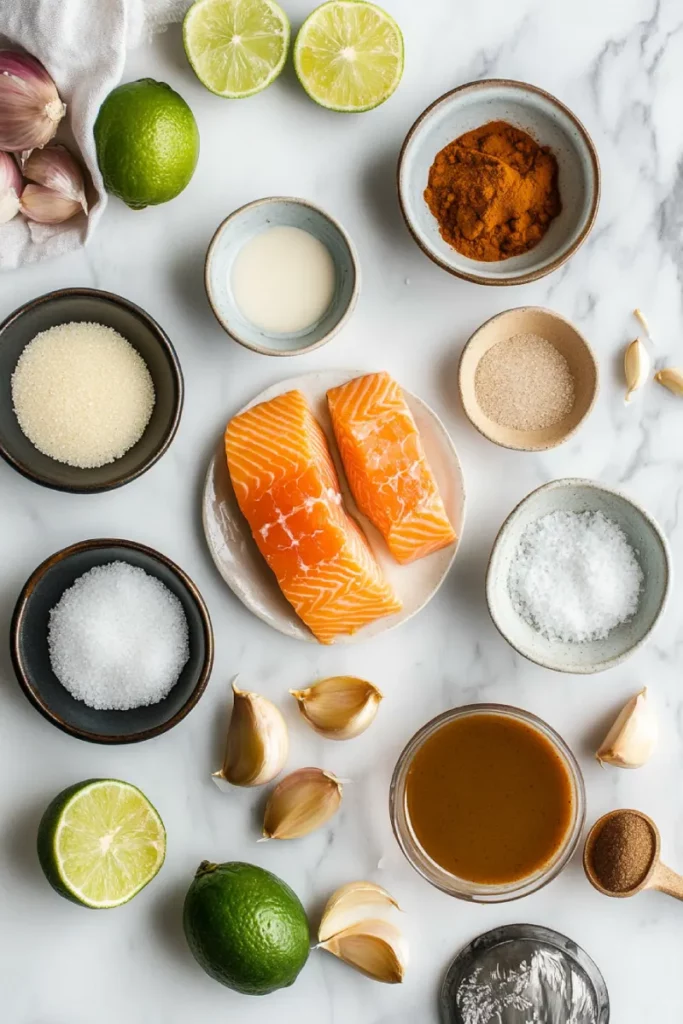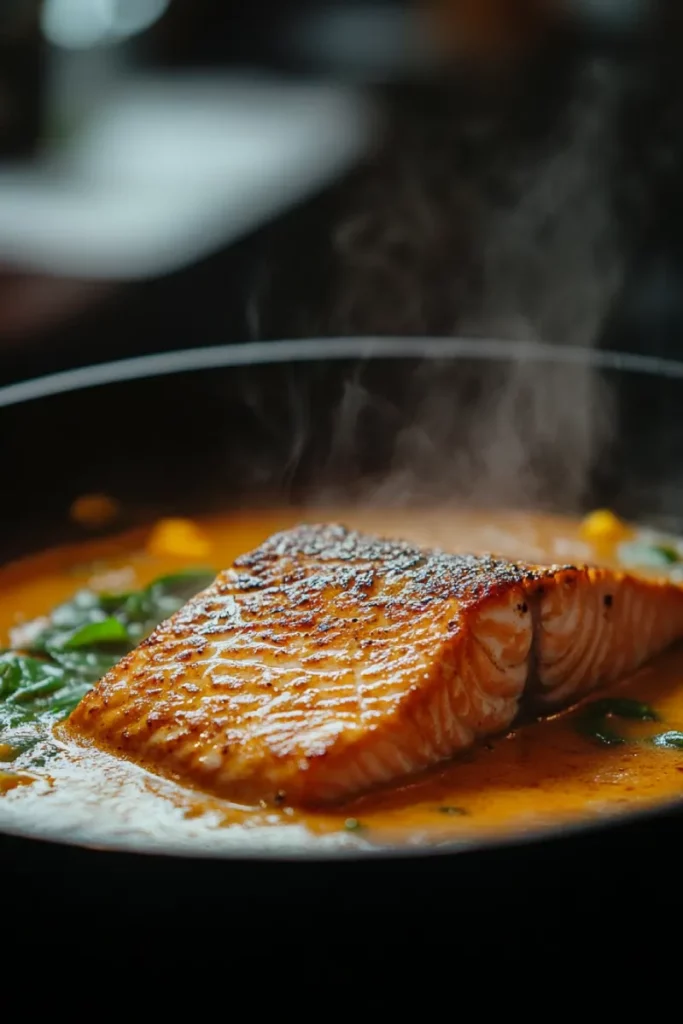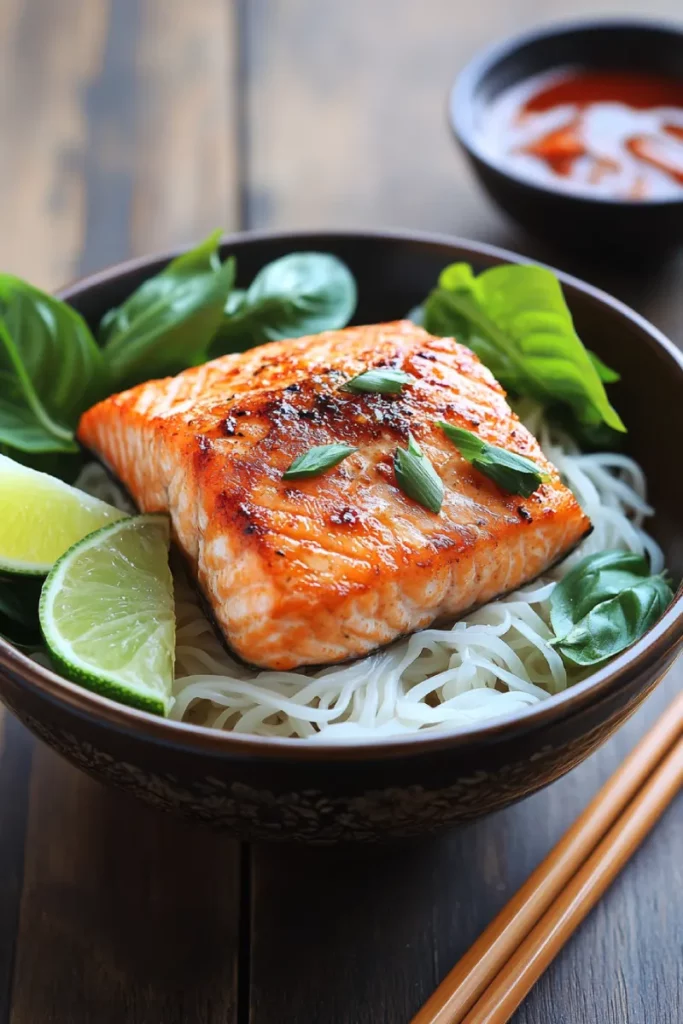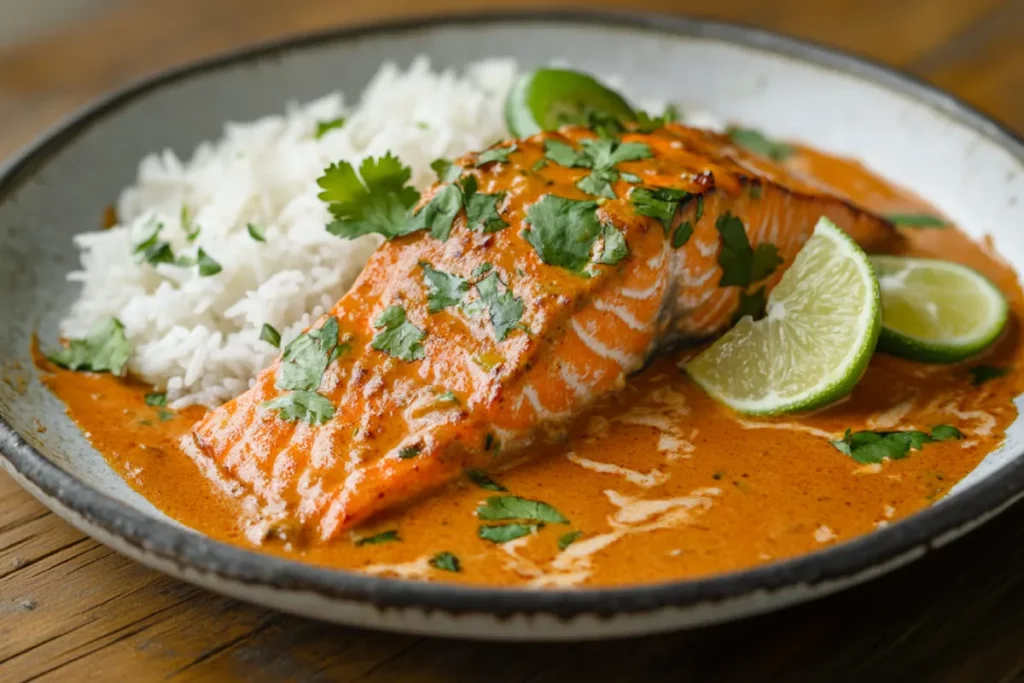Thai salmon is a deliciously bold twist on traditional salmon recipes. Infused with aromatic herbs, savory sauces, and sweet-heat blends that define Thai cuisine, this dish is perfect for busy weeknights or flavorful dinners. In this article, you’ll learn exactly how to make Thai salmon, marinate it right, cook it in various ways (including the air fryer), and even pair it with the best Thai sides. We’ll answer common questions like “What is Thai salmon made of?” and “Is Thai salmon healthy?” so you get a clear picture of the dish. Plus, we’ll guide you through avoiding common mistakes and keeping leftovers just as good the next day. Let’s get cooking with Thai salmon.
Thai Salmon recipe basics and key ingredients
What is Thai salmon made of?
Thai salmon combines rich, fatty salmon with bold flavors from Southeast Asia. The dish usually includes a base of:
- Coconut milk
- Red or green Thai curry paste
- Lime juice
- Brown sugar or honey
- Fish sauce or soy sauce
- Garlic and fresh ginger
- Fresh herbs like cilantro or Thai basil
- Optional heat: red pepper flakes or fresh chili
These ingredients work together to deliver a balance of sweet, salty, sour, and spicy. You can find most items in a typical grocery store, especially in the Asian food aisle.
Internal Link: Try this flavor-packed twist: Seared Scallops with Spicy Cajun Cream Sauce
Essential Thai pantry staples for this dish
To make Thai salmon often, it helps to keep some Thai essentials on hand:| Ingredient | Purpose |
|---|---|
| Thai curry paste | Base flavor for sauces and marinades |
| Fish sauce | Adds saltiness and umami depth |
| Coconut milk | Creates a creamy, slightly sweet sauce |
| Limes | Adds brightness and acidity |

Keep these on hand and Thai salmon becomes a quick go-to dinner. If you like trying new combinations, Easy Baked Ranch Chicken also makes for a flavorful alternative.
Cooking methods for Thai salmon
Oven-baked vs. pan-seared Thai salmon
Both oven-baking and pan-searing offer great ways to cook Thai salmon. Each method brings something unique to the table.
Oven-Baked Thai Salmon: Baking gives you tender, evenly cooked fish with very little effort. Just preheat your oven to 400°F, place the marinated salmon on a foil-lined baking sheet, and bake for about 12–15 minutes. If using skin-on fillets, bake skin-side down for crispier results.
Pan-Seared Thai Salmon: For a crispier exterior, pan-searing is the way to go. Heat oil in a skillet over medium-high heat, and cook the salmon 3–4 minutes per side. You’ll get a golden crust and a faster cook time, but you’ll need to keep a closer eye on the fish to avoid burning the sugars in the sauce.

If you enjoy crispy textures, you might also love Garlic Parmesan Cheeseburger Bombs as a fun, crunchy dinner idea.
Can I make Thai salmon in the air fryer?
Absolutely. Thai salmon works beautifully in the air fryer, especially when you’re short on time. Preheat the air fryer to 375°F and cook the salmon for 10–12 minutes, depending on thickness.
Pro Tips for Air Frying Thai Salmon:
- Use parchment liners or nonstick spray to prevent sticking.
- Don’t overcrowd the basket—airflow is key.
- Brush extra marinade halfway through for stronger flavor.
The air fryer keeps the fish moist while delivering a light crisp to the surface. It’s also a great method if you’re avoiding extra oils.
Marinating Thai salmon properly
How long should I marinate salmon in Thai sauce?
For the best flavor, marinate Thai salmon for at least 30 minutes, but no longer than 2 hours. Salmon is a delicate fish. Leaving it too long in acidic ingredients like lime juice can start to “cook” the fish and ruin the texture.
Quick marinade guide:
- Minimum time: 30 minutes (for a quick flavor boost)
- Ideal time: 1 hour (balanced flavor and moisture)
- Maximum time: 2 hours (to avoid over-curing the fish)
If you’re in a rush, even a 20-minute marinade can deliver solid flavor. Just be sure the sauce includes the essentials: lime juice, soy or fish sauce, Thai curry paste, and a touch of sweetness like brown sugar.
Curious about short-prep meals? Check out this 4-Ingredient Natural Mounjaro Recipe that’s quick and flavorful.
Best marinades for Thai salmon flavor
Thai salmon marinades center around the balance of sweet, salty, sour, and spicy. Here’s a simple, go-to marinade recipe that works every time:
Simple Thai Salmon Marinade:
- 2 tbsp Thai red curry paste
- 2 tbsp soy sauce or fish sauce
- 1 tbsp lime juice
- 1 tbsp brown sugar or honey
- 1 tbsp olive oil
- 1 clove minced garlic
- 1 tsp grated ginger
- Optional: ½ tsp crushed red pepper flakes
Whisk everything together, coat the salmon, and let it soak in those flavors. Use a zip-top bag or glass container to keep it sealed and evenly coated in the fridge.
Want more Asian-inspired sauces? Try the Cream Sauce Base HelloFresh Recipe as a creamy alternative for chicken or seafood.For more air fryer magic, check out this reader favorite: Frozen Salmon in Air Fryer
Thai-style salmon curry explained
What is Thai-style salmon curry?
Thai-style salmon curry is a rich, aromatic dish made by simmering salmon fillets in a creamy coconut-based sauce flavored with Thai curry paste. It’s hearty, comforting, and quick to prepare.
The curry typically includes:
- Thai red or green curry paste
- Coconut milk
- Salmon fillets (skinless or skin-on)
- Vegetables like bell peppers, snap peas, or carrots
- Fresh lime juice and herbs for garnish
The salmon is either seared or added raw into the sauce and gently simmered until fully cooked. The sauce absorbs the salmon’s oils, making it even more flavorful.
Serve it over jasmine rice, rice noodles, or cauliflower rice for a complete meal.
For a similar rich and creamy seafood dish, you’ll enjoy Charoset Recipe – Unique Sweet Treat, perfect alongside savory mains.
Best Thai curry paste for fish
When it comes to pairing curry paste with fish like salmon, red curry paste is the top pick. It has the right balance of heat, herbs, and garlic without overpowering the salmon’s delicate texture.
Red Curry Paste Highlights:
- Medium heat
- Rich color from red chilies
- Balanced flavor (lemongrass, galangal, garlic)
- Works well with coconut milk
Green Curry Paste, on the other hand, is spicier and brighter, great if you prefer more kick. Just go light on it if you’re new to Thai spice levels.
Looking for creative ingredient pairings? You might also like this Matcha Crepe Roll Cake Recipe as a sweet finish to your Thai dinner night.
Thai salmon meal ideas
What goes well with Thai salmon?
Thai salmon pairs best with ingredients that balance or complement its bold flavor. Think light, citrusy, or creamy textures and refreshing sides that don’t compete with the dish.
Here are top sides that go perfectly with Thai salmon:
- Jasmine rice – classic and aromatic
- Coconut rice – adds creaminess to match the sauce
- Rice noodles – ideal for curry-style dishes
- Steamed bok choy or baby spinach – healthy and neutral
- Asian cucumber salad – cool and tangy
You can also serve Thai salmon in a lettuce wrap for a low-carb option or in a grain bowl with brown rice, edamame, and pickled veggies.
Want more sweet-savory fusion dishes? Don’t miss the Heaven on Earth Cake—a great dessert after a spicy main.
Best Thai-inspired side dishes
Pairing your Thai salmon with a proper side dish can turn a simple meal into a full dining experience. Here are three flavorful Thai-inspired sides:
1. Thai Mango Salad:
Made with shredded green mango, red onion, peanuts, and lime dressing. Adds brightness and crunch.
2. Coconut Sticky Rice:
Perfect for soaking up curry sauce or balancing spicy flavors. Cook glutinous rice in coconut milk with sugar and a pinch of salt.
3. Thai Pickled Vegetables:
Quick-pickled carrots, daikon, and cucumbers bring a sweet and tangy crunch that complements fatty fish.

For a refreshing drink that pairs well, try this Matcha Latte Recipe. Its earthiness balances the Thai spice beautifully.
Health benefits of Thai salmon
Is Thai salmon healthy?
Yes, Thai salmon is a nutrient-packed dish. It combines the heart-healthy omega-3 fats found in salmon with antioxidant-rich herbs and anti-inflammatory ingredients like ginger, garlic, and lime.
Here’s why Thai salmon is a smart choice:
- Omega-3 fatty acids reduce inflammation and support brain health.
- Protein-rich: One serving provides around 22–25g of high-quality protein.
- Low-carb option when served with veggies or cauliflower rice.
- Natural anti-inflammatories: Ingredients like turmeric (in some curry pastes), garlic, and ginger support digestion and joint health.
It’s also adaptable. You can make it dairy-free, gluten-free, or even keto-friendly with the right swaps.
Interested in natural health foods? Check out the Natural Mounjaro Recipe Tea packed with powerful ingredients.
Nutrition breakdown and calories
Here’s a sample nutrition profile for one serving of Thai salmon (about 5–6 oz salmon fillet + sauce):| Nutrient | Amount (approx.) |
|---|---|
| Calories | 350–400 kcal |
| Protein | 22–25 g |
| Total Fat | 25–28 g |
| Carbohydrates | 8–12 g |
This dish is also naturally low in sugar unless you add sweet chili sauce. To keep it lighter, skip the rice and serve with steamed vegetables.
For more light yet satisfying dishes, don’t miss the Biscoff Cheesecake Secrets—a creamy indulgence you can tweak to fit your macros.
PART 7: Common mistakes when cooking Thai salmon
Overcooking and how to avoid it
One of the most common mistakes with Thai salmon is overcooking the fish. Salmon cooks quickly, and when paired with sugary sauces, it can dry out or even burn if you’re not careful.
Here’s how to avoid it:
- Use a thermometer: Salmon is done at an internal temp of 125°F for medium, or 135°F for well-done.
- Watch the cook time: Whether you’re baking, air frying, or pan-searing, 10–15 minutes is often plenty.
- Let it rest: Just like steak, letting salmon rest for 3–5 minutes allows the juices to settle.
Keep an eye out if you’re cooking it in sauce—the coconut milk can make it harder to judge by appearance alone.
Cooking fish at the right temp? You’ll love how perfectly Air Fryer Frozen Chicken Wings turn out with the same approach.
Balancing spice and sweetness in Thai sauce
Thai salmon should hit sweet, salty, spicy, and sour notes, but many home cooks make it too spicy or too sweet. This throws off the signature Thai balance.
Fixes for common flavor issues:
- Too salty? Add a splash of lime juice or a bit more coconut milk.
- Too spicy? Stir in a spoonful of sugar or a dash of heavy cream.
- Too sweet? Add more fish sauce or a pinch of chili flakes.
- Too bland? Toast your curry paste in oil before adding liquids for extra depth.
Always taste your sauce before adding it to the fish—this way, you can adjust it without overcooking the salmon.
If you enjoy bold flavors done right, don’t skip the Brazilian Mounjaro Recipe with Apple Cider Vinegar—perfectly balanced and vibrant.
PART 8: Storing and reheating Thai salmon
How to store leftovers safely
Thai salmon stores well if done correctly. To keep it tasting fresh and safe to eat, follow these simple rules:
Refrigerator storage:
- Allow the salmon to cool to room temperature first.
- Store in an airtight container.
- Keep in the fridge for up to 3 days.
Freezer storage:
- Wrap individual salmon pieces tightly in foil or plastic wrap.
- Place in a zip-top freezer bag or airtight container.
- Freeze for up to 2 months.
Label your container with the date so you know when to use it by. To prevent sauce separation, freeze the salmon and curry sauce separately, if possible.
For freezer-friendly dinner ideas, see this creamy and savory Tortilla Quiche Bake.
Best reheating methods to keep flavor intact
The key to reheating Thai salmon is low and slow—preserve the moisture and avoid drying out the fish.
Stovetop (best method):
- Place salmon in a skillet with a few tablespoons of water or leftover curry sauce.
- Cover and warm over low heat for 4–5 minutes.
Microwave (quickest):
- Use a microwave-safe container with a loose-fitting lid.
- Add a splash of water or sauce.
- Heat at 50% power for 1–2 minutes, checking often.
Oven:
- Preheat to 275°F.
- Wrap salmon in foil with a spoon of sauce.
- Heat for 10–12 minutes.
Avoid reheating at high temperatures—it’ll cook the salmon again and make it tough.
Need another make-ahead favorite? Try the Chicken Parm Cottage Cheese Bowl—tastes just as great reheated the next day.
FAQ About Thai Salmon
What is Thai salmon made of?
Thai salmon combines salmon fillets with Thai-inspired ingredients like red or green curry paste, coconut milk, lime juice, garlic, and fish sauce. The result is a bold, flavorful dish with the perfect balance of sweet, spicy, salty, and sour.
What goes well with Thai salmon?
Thai salmon pairs well with jasmine rice, coconut rice, rice noodles, or steamed vegetables like bok choy. Fresh sides like Thai mango salad or cucumber slaw also make excellent pairings to balance the rich sauce.
How long should I marinate salmon in Thai sauce?
Marinate the salmon for at least 30 minutes and no more than 2 hours. Salmon is delicate, and too much acid from lime or vinegar can change its texture if marinated too long.
What is Thai-style salmon curry?
Thai-style salmon curry is a dish where salmon is gently simmered in coconut milk with Thai curry paste, vegetables, and herbs. It’s creamy, spicy, and served best over rice or noodles.
Can I make Thai salmon in the air fryer?
Yes. Preheat your air fryer to 375°F and cook marinated salmon for 10–12 minutes. It’s fast, crispy on the outside, and stays moist inside.
Is Thai salmon healthy?
Yes, Thai salmon is rich in omega-3 fats, protein, and antioxidants. It’s low-carb and customizable to be gluten-free or dairy-free depending on your ingredients.
Conclusion
Thai salmon is more than just a weeknight dinner—it’s a flavorful experience rooted in the bold, fresh flavors of Thai cuisine. Whether you prefer it baked, seared, or air-fried, this dish is easy to prepare and flexible enough to fit your dietary goals. By understanding how to marinate it properly, pair it with the right sides, and reheat it without losing texture, you’ll enjoy Thai salmon again and again. Ready to make your kitchen smell like Thailand? Now you’ve got everything you need.



